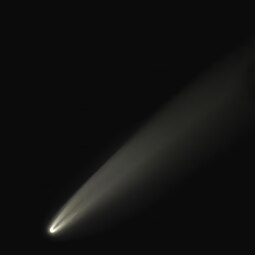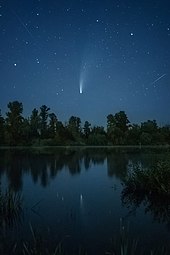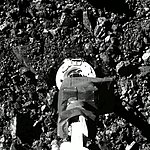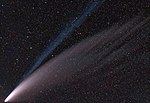C/2020 F3
 | |
| 發現 | |
|---|---|
| 發現者 | 近地天體觀測 |
| 發現日 | 2020年3月27日[1] |
| 軌道特性考 | |
| 曆元 | 2458953.5(2020年4月4日) |
| 觀測次數 | 376 |
| 遠日點 | 538 AU(入境) 710 AU(離境) |
| 近日點 | 0.29478 AU |
| 半長軸 | 270 AU(入境) 355 AU(離境) |
| 離心率 | 0.99921 |
| 週期 | ~4,500年(入境)[2] ~6,800年(離境) |
| 軌道傾角 | 128.93° |
| 升交點黃經 | 61.01° |
| 近心點角 | 37.28° |
| 蒂塞朗參數 | −0.408 |
| 與地球軌道相交 最小距離 | 0.36 AU(54 × 106 km;140 LD) |
| 與木星軌道相交 最小距離 | 0.81 AU(121 × 106 km) |
| 彗核尺寸 | ~5.0 km(3.1 mi)[1] |
| 彗星整體星等 (M1) | 12.1 7.5[3] |
| 歷次近日點 日期 | 2020年7月3日 |
C/2020 F3 (NEOWISE),又稱NEOWISE彗星或音譯尼歐懷茲彗星[4],是一顆长周期彗星,軌道呈拋物線形,由天文學家於2020年3月27日在廣域紅外線巡天探測衛星(WISE)太空望遠鏡的NEOWISE任務[註 1]期間發現。當時,它的視星等為18等,距離太陽2 AU(300 × 106 km;190 × 106 mi),距離地球1.7 AU(250 × 106 km;160 × 106 mi)[5]。
NEOWISE彗星是自1997年海爾-博普彗星以來北半球最明亮的彗星[6]。它被專業和業餘觀察者廣泛拍攝,甚至居住在市中心附近和光污染地區的人也發現了它[7]。雖然它距離太陽太近,無法在近日點觀測到,但它從近日點出現的亮度約為0.5至1等,亮度足以用肉眼看到[8]。在黑暗的天空下,人們可以用肉眼看見它[9],,並在整個2020年7月一直可以用肉眼看見[10]。到7月30日,彗星的視星等已達到5等左右[11],需要在市區附近用雙筒望遠鏡才能找到彗星的位置。
對於北半球的觀察者來說,這顆彗星可以在北斗七星下方的西北地平線上看見。該彗星位於赤緯+45度以北,於2020年7月中旬整夜可見。7月30日,NEOWISE彗星進入后发座,位於明亮的恆星大角星下方。
歷史及觀察
[编辑]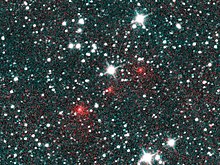
該天體是由NEOWISE計劃下的一個團隊於2020年3月27日使用近地天體觀測太空望遠鏡所發現[1]。它於3月31日獲歸類為彗星,並於4月1日以NEOWISE命名[5]。其系統名稱為C/2020 F3,表示其為一顆非週期彗星,是2020年3月下半月發現的第三顆彗星。
2020年7月3日,NEOWISE彗星最接近太陽(近日點),距離太陽0.29 AU(43 × 106 km;27 × 106 mi)。穿過行星區將使彗星的軌道周期從約4,500年增至約6,800年[2]。它於2020年7月23日凌晨1時09分(协调世界时)最接近地球,距離地球0.69 AU(103 × 106 km;64 × 106 mi),當時彗星位於大熊座內[12]。
7月初,人們可以在早晨的天空中看見這顆彗星,位於東北地平線上方和五車二下方。從地球上看,該彗星在2020年6月11日至7月9日期間距離太陽不到20度。到2020年6月10日,彗星逐漸消失在太陽的強光中,當時其視星等為7等[11],而彗星距離太陽0.7 AU(100 × 106 km;65 × 106 mi),距離地球1.6 AU(240 × 106 km;150 × 106 mi)。當彗星在2020年6月22日進入太陽和太陽圈探測器太空船的LASCO C3儀器的視野時,彗星的亮度達到約3等,此時彗星距離太陽0.4 AU(60 × 106 km;37 × 106 mi),距離地球1.4 AU(210 × 106 km;130 × 106 mi)[11]。
到7月初,NEOWISE彗星的亮度已升至1等[13][14],遠超當年的彗星C/2020 F8和C/2019 Y4的亮度。到7月,它還發展出第二條彗尾。第一條彗尾是藍色的,由氣體和離子組成。由於鈉含量過高,彗尾也出現紅色分離。第二條雙彗尾呈金色,由彗星塵構成,類似海爾-博普彗星的彗星。這顆彗星比C/2011 L4更亮[15],但其亮度不及1997年的海爾-博普彗星。彗星在經過近日點後開始變暗,到7月中旬其亮度降至2等[16]。七月中旬以後,其彗核活動逐漸減弱,此後其綠色彗髮清晰可見。
2020年7月13日,行星科學研究所的輸入/輸出設施確認其存在鈉尾[17]。鈉尾僅在非常明亮的彗星(例如海爾-波普彗星和ISON彗星)中觀測到。
根據紅外線特徵,估計彗核直徑約5公里[1]。彗核的大小與百武二號彗星以及許多短週期彗星(如恩克彗星、龐士-溫尼克彗星、塔特爾彗星、沃夫彗星及包瑞利彗星)相似[18]。到7月5日,美國太空總署的派克太陽探測器已拍攝到該彗星的圖像,天文學家也因此估算出彗核的直徑約為5公里[19]。2020年7月下旬,天文學家也報告其他觀察結果,包括與彗髮形態[20]和光譜發射相關的觀察結果[21][22][23]。2020年7月31日,阿雷西博天文台的電波光譜研究中觀測到OH18厘米輻射的強烈偵測[24]。2020年8月14日,據報彗星自轉的週期為7.58±0.03 hr[25]。
在彗星到達近日點並最接近地球後,許多天文愛好者建議將其視為一顆大彗星[26][27][28][29][30][31]。其他人則認為,它不夠明亮,彗尾也不夠明顯,不符合大彗星的標準[32]。回顧過去,在隨後的幾年裏,NEOWISE彗星被普遍認為是一顆大彗星[33][34]。
軌道
[编辑]2020年6月29日凌晨1時47分(協調世界時),NEOWISE彗星的逆行軌道穿過黃道以北,與黃道的夾角約為129度[13][35]。它於2020年7月3日最接近太陽(近日點),距離太陽0.29 AU(43 × 106 km;27 × 106 mi)。這次穿越將彗星的軌道周期從約4,400年延長至約6,700年[2]。7月18日,彗星在赤緯+48度達到頂峰,並位於赤緯+42度以內[12]。它與地球最近距離的時間為2020年7月23日凌晨1時09分(協調世界時),距離地球0.69 AU(103 × 106 km;64 × 106 mi),當時彗星位於大熊座內[12]。
-
彗星呈拋物線形的軌道圖
-
彗星在天空中的位置——逆行環是由地球圍繞太陽旋轉的視差所引起,彗星在最接近地球時的移動幅度最大
-
C/2020 F3 繞太陽運行的動畫
C/2020 F3 · 太陽 · 水星 · 金星 · 地球 · 火星
創作性的彗星名稱
[编辑]中國的全國科學技術名詞審定委員會將C/2020 F3彗星定名為「新智」彗星,是因為它是近期一顆比較明亮,受人注目的彗星。「新智」這個命名並非音譯,亦非意譯,由委員會的天文學家孫小淳命名[36],命名違反國際天文聯會彗星命名法則[37],或者彗星中文譯名準則[38][39][40]。雖然國際天文聯會是世上唯一可以正式命名彗星的官方機構,發現者或發現機構,以及翻譯者都無權自行按照他們的喜好將彗星另行命名,但是中國全國科學技術名詞審定委員會認為「新智」的名字有創意、易讀而通過。是中國大陸罕有將眾多名為 NEOWISE 的彗星中抽出其中一顆,公布創作出來的中文彗星名稱。
照片集
[编辑]按照时间顺序排列:
-
7月10日,烏克蘭敖德薩
-
7月10日,義大利拉斯特拉-阿錫尼亞
-
7月11日,烏克蘭敖德薩州
-
7月12日,瑞士沙夫豪森
-
7月14日,德國普爾斯尼茨
-
7月17日,烏克蘭基輔州
-
7月21日,加拿大魁北克
-
7月26日,法國卡巴里霍斯峰
注解
[编辑]參考資料
[编辑]- ^ 1.0 1.1 1.2 1.3 Mace, Mikayla. Comet NEOWISE Sizzles as It Slides by the Sun, Providing a Treat for Observers. Infrared Processing and Analysis Center. 2020-07-08 [2020-07-13]. (原始内容存档于2020-07-13).
- ^ 2.0 2.1 2.2 JPL Horizons barycentric solution for epoch 1800 (before entering planetary region)
Goto JPL Horizons
1800-Jan-01 is "PR = 1.64 × 106/365.25 days" = 4490 years
2200-Jan-01 is "PR = 2.48 × 106/365.25 days" = 6789 years
(For long-period comets on multi-thousand year orbits, asymmetric outgassing will affect the highly sensitive orbital period and eccentricity.) - ^ MPC Orbit (MPCORB) database - AllComet. Minor Planet Center. [2024-12-28]. (原始内容存档于2024-03-03).
- ^ 23年來最亮彗星尼歐懷茲 肉眼就看的到. 人間福報. 2020-07-09 [2020-07-10]. (原始内容存档于2020-08-14).
- ^ 5.0 5.1 COMET C/2020 F3 (NEOWISE). Minor Planet Electronic Circulars. 2020-04-01,. 2020-G05 [2020-07-13]. (原始内容存档于2020-07-15).
On behalf of NEOWISE (C51), J. Masiero reported on March 31 UT that this object showed clear signs of cometary activity.
- ^ Stein, Emma. 抓緊 21 世紀最亮彗星 NEOWISE 最後身影,下次來訪要等 6,800 年. 科技新報. 2020-07-24 [2020-07-25]. (原始内容存档于2020-07-26).
- ^ Alex. 追星最後機會,NEOWISE 彗星 6,800 年後再見. DCFever. 2020-07-20 [2020-08-01]. (原始内容存档于2020-08-14).
- ^ Mark Armstrong. Don't miss Comet NEOWISE in the evening. Astronomy Now. 2020-07-17 [2020-07-29]. (原始内容存档于2020-07-19).
- ^ How to see Comet NEOWISE. EarthSky. [July 11, 2020]. (原始内容存档于July 11, 2020).
- ^ Seiichi Yoshida. C/2020 F3 ( NEOWISE ). [April 4, 2020]. (原始内容存档于May 14, 2020).
- ^ 11.0 11.1 11.2 C/2020 F3 (NEOWISE) plot @ Comet Observation database (COBS) (mm.m column). [July 18, 2020]. (原始内容存档于July 16, 2020).
- ^ 12.0 12.1 12.2 Horizons Web-Interface. ssd.jpl.nasa.gov. [July 24, 2020]. (原始内容存档于July 8, 2020). Ephemeris Type: Observer, Observer Location: Geocentric 500, Note: Closest approach occurs when deldot flips from negative to positive; Maximum northern declination is 2020-Jul-18 07h)
- ^ 13.0 13.1 Dickinson, David. Comet F3 NEOWISE May Perform in July. Universe Today. June 30, 2020 [June 30, 2020]. (原始内容存档于July 15, 2020).
- ^ ATel #13853: Morphology and Photometry of Comet C/2020 F3 (NEOWISE) from SOHO. Astronomer's Telegram. July 2, 2020 [July 10, 2020]. (原始内容存档于July 5, 2020).
- ^ MacRobert, Alan. Updates on Comet PanSTARRS. Sky & Telescope. 2013-04-02 [2020-11-11]. (原始内容存档于2020-11-12).
- ^ Nick James, Visual observations page, Comet Section (British Astronomical Association), 2020-07-06 [2020-07-13], (原始内容存档于2020-07-16)
- ^ NEOWISE: Rare Image of a Comet's Sodium Tail. Planetary Science Institute. July 13, 2020 [July 14, 2020]. (原始内容存档于July 14, 2020).
- ^ JPL Small-Body Database Search Engine: numbered comets and diameter > 4 (km) and diameter < 6 (km). JPL Solar System Dynamics. [July 13, 2020]. (原始内容存档于July 15, 2020).
- ^ Miloslav Druckmuller; Robert Nemiroff; Jerry Bonnell, The Tails of Comet NEOWISE, NASA, 2020-07-11 [2020-07-11], (原始内容存档于2020-07-17)
- ^ Manzini, Federico; et al. ATel #13884: Morphological Structures in the inner coma of comet C/2020 F3 (NEOWISE). The Astronomer's Telegram. 2020-07-21 [2020-07-21]. (原始内容存档于2020-07-24).
- ^ Lin, Zhong-Yi; et al. ATel #13886: The Sodium Emission of comet C/2020 F3 (NEOWISE) observed at KenTing and Lulin observatory. The Astronomer's Telegram. 2020-07-22 [2020-07-22]. (原始内容存档于2020-07-22).
- ^ Krishnakumar, Arvind; et al. ATel #13897: CN, C2, C3 production rates of Comet C/2020 F3 (NEOWISE) as observed from Himalayan Chandra Telescope, Hanle, India. The Astronomer's Telegram. 2020-07-26 [2020-07-26]. (原始内容存档于2020-07-27).
- ^ Mugrauer, M.; Bischoff, R. ATel #13928: Follow-Up Spectroscopy of Comet C/2020 F3. 2020-08-09 [2020-08-10]. (原始内容存档于2020-09-29).
- ^ Smith, Allison; et al. ATel #13968: Strong detection of OH 18-cm emission from Comet C/2020 F3 (NEOWISE). The Astronomer's Telegram. 2020-08-25 [2020-08-25]. (原始内容存档于2020-09-29).
- ^ Drahus, Michal; et al. ATel #13945: Rotation of Comet C/2020 F3 (NEOWISE). The Astronomer's Telegram. 2020-08-14 [2020-08-18]. (原始内容存档于2020-09-29).
- ^ Weekly Information about Bright Comets (2020 July 18: North). Seiichi Yoshida. 2020-07-18 [2020-07-18]. (原始内容存档于2020-07-19).
- ^ Seiichi Yoshida's Diary of Comet Observations (2020). Seiichi Yoshida. 2020-07-19 [2020-07-19]. (原始内容存档于2020-07-20).
- ^ Comet NEOWISE Updtae: Easy To See In The Evening! When And How To See Comet NEOWISE. Farmer's Almanac. 2020-07-18 [2020-07-19]. (原始内容存档于2020-07-19).
- ^ APOD: 2020 July 13 – Comet NEOWISE Rising over the Adriatic Sea. NASA. 2020-07-18 [2020-07-19]. (原始内容存档于2020-07-15).
- ^ Jamie Carter. Act Now For Your Best And Last Chance To See Comet NEOWISE This Weekend. Here's When, Where And How. Forbes. 2020-07-23 [2020-07-29]. (原始内容存档于2020-07-29).
- ^ The Great Comet of 2020 (NEOWISE). The University of Arizona's Mt. Lemmon Skycenter. 2020-07-23 [2020-07-29]. (原始内容存档于2020-07-26).
- ^ Rao, Joe. The curtain is about to come down on Comet NEOWISE. Space.com. 2020-07-24 [2020-07-27]. (原始内容存档于2020-07-26).
- ^ APOD: 2022 July 26 - Comet NEOWISE Rising over the Adriatic Sea. NASA. 2022-07-26 [2024-10-17].
- ^ Great Comets: What Are They, And When Will the Next Comet Be Visible?. Star Walk. 2024-10-16 [2024-10-17].
- ^ NEOWISE (C/2020 F3). JPL, NASA. [2020-11-20]. (原始内容存档于2020-07-27).
- ^ 全国科技名词委发布彗星C/2020 F3的中文名“新智彗星”. 全国科学技术名词审定委员会事务中心. 2020-07-16 [2020-07-17]. (原始内容存档于2020-07-17) (中文(中国大陆)).
- ^ Naming of Astronomical Objects. International Astronomical Union. [2020-08-20]. (原始内容存档于2013-11-04).
- ^ 香港天文學會討論區《掩星組文件》彗星中文譯名準則. [2020-08-20]. (原始内容存档于2020-03-25) (中文(香港)).
- ^ 香港太空館、香港天文學會. 彗星 第三版. 香港太空館. 2014: 48–55. ISBN 978-9627054-12-2 (中文(香港)).
- ^ 余惠俊. 彗星中文譯名準則 (PDF). 臺北星空 (臺北市立天文科學教育館). 2014, 64: 8–11 [2023-01-10]. (原始内容存档 (PDF)于2023-01-10) (中文(臺灣)).
外部連結
[编辑]- Comet C/2020 F3 (NEOWISE)(页面存档备份,存于互联网档案馆) - CometWatch
- New Comet C/2020 F3 (NEOWISE)(页面存档备份,存于互联网档案馆) – Ernesto Guido & Adriano Valvasori
- C/2020 F3 (NEOWISE)(页面存档备份,存于互联网档案馆) – AiM-Project-Group
- NASA JPL小天體数据库瀏覽器上的C/2020 F3







